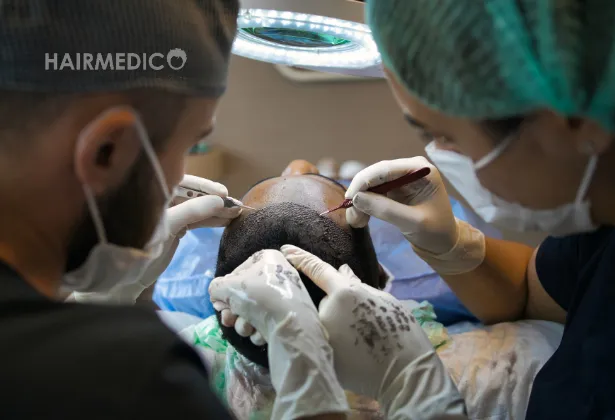
Hair transplant technology is more advanced than ever in 2025. Innovations in technique, surgical precision, and biological enhancement are transforming the patient experience and clinical outcomes. Today’s procedures are not only more effective, but also more personalized, faster to recover from, and nearly undetectable.
This guide explores the most impactful trends and innovations in hair transplantation in 2025, highlighting how the industry is evolving to meet higher aesthetic standards and patient expectations.
AI-driven diagnostic systems are now commonly used to map the scalp, simulate future hair loss, and optimize graft distribution. These tools help ensure more accurate planning and realistic, age-appropriate results.
Learn more about personalized approaches on the Hair Transplant Techniques page.
In 2025, Sapphire FUE has become the go-to method at leading clinics. The sapphire blade allows for finer incisions and more accurate graft placement, promoting faster healing and denser hairlines.
Explore its benefits on the Sapphire Hair Transplant Technique page.
DHI, or Direct Hair Implantation, allows for graft placement without prior channel creation. Using a Choi Implanter Pen, the surgeon can control angle, depth, and direction—ideal for frontal zones and high-density results.
See how it compares to FUE on the FUE vs DHI Hair Transplant page.
In long procedures, cooling extracted grafts using hypothermic solutions helps reduce cellular stress. This enhances survival rates and is especially useful in mega sessions involving 4000+ grafts.
With Long Hair FUE, patients no longer need to shave their donor or recipient areas. This method is ideal for public figures and professionals who need discreet results with zero downtime.
Still in the early adoption phase, stem cell technology uses follicular stem cells to regenerate miniaturized follicles. It holds promise for patients with poor donor supply or early-stage hair loss.
Exosomes are cell-derived messengers that trigger tissue repair and new cell growth. In 2025, exosome therapy is increasingly used alongside PRP to stimulate graft survival, faster healing, and improved density.
Read about recovery options on the Hair Transplant Aftercare page.
Platelet-Rich Plasma injections continue to be used post-op to improve healing, enhance blood circulation, and accelerate visible results in both scalp and facial transplants.
Turkey remains the top destination for hair transplants in 2025 due to cost efficiency, medical quality, and full-service packages. Clinics like Hairmedico in Istanbul provide packages that include hotel accommodation, transfers, post-op products, and follow-up care.
Understand why Istanbul leads on the Hair Transplant in Turkey page.
Facial hair restoration is now a major focus, especially for men looking to improve beard density and women seeking fuller eyebrows. Specialized techniques allow for precise follicle placement and natural shaping.
Learn how it works on the Beard Transplant Guide page.
Donor area quality
The number, strength, and flexibility of your donor hair determine your eligibility for each technique.
Hair loss pattern
Some patients experience vertex thinning, while others deal with receding hairlines. Knowing your progression helps with long-term planning.
Surgical goals and lifestyle
Are you aiming for maximum density or a discreet enhancement? Do you prefer not to shave your head? These decisions influence technique selection and recovery strategy.
Hair transplantation in 2025 represents a unique blend of surgical artistry, high-tech precision, and regenerative science. With the rise of personalized planning, cold preservation, AI diagnostics, and advanced tools like sapphire blades and implanter pens, patients can expect better outcomes than ever before.
To learn how these innovations can work for you, explore our full process on the Hair Transplant in Turkey page or start a consultation with our team.
As we move beyond 2025, the next chapter in hair transplant technology will focus on regenerative science, seamless recovery, and even more personalized results. With growing demand for natural-looking outcomes, clinics are combining FUE, Sapphire FUE, DHI, and regenerative treatments to deliver stronger graft survival and faster visible growth. The global rise of Hair Transplant Turkey will continue, as Istanbul remains the leading destination for international patients seeking world-class care at competitive prices.
In the near future, fully regenerative therapies—such as hair cloning, advanced stem cell applications, and topical growth-factor delivery systems—are expected to reshape the industry. These innovations could create unlimited donor supply, allowing patients with severe baldness to achieve higher density without compromise. At the same time, AI-based analytics will expand further, helping surgeons predict future hair loss and design long-term strategies that protect the hairline for decades, not just months.
Another major trend is the shift toward minimally invasive, no-shave hair transplant procedures, ideal for public figures, actors, athletes, and professionals who want aesthetic improvement without social downtime. Long Hair FUE and refined implanter techniques are making it possible for patients to return to work the next day, with undetectable signs of surgery.
From a patient-experience perspective, 2025 and beyond will be defined by full-service medical hospitality, transparent pricing, and continuous post-operative support. Clinics that offer personalized follow-up, PRP or exosome maintenance, and long-term hair preservation programs will set the new standard.
In summary, the future of hair restoration will be smarter, faster, more natural, and more regenerative. Whether through advanced Sapphire FUE, precision DHI, AI mapping, or emerging stem-cell-based solutions, patients can expect results that are closer to nature than ever before — with stronger density, refined hairlines, and lifelong growth potential.